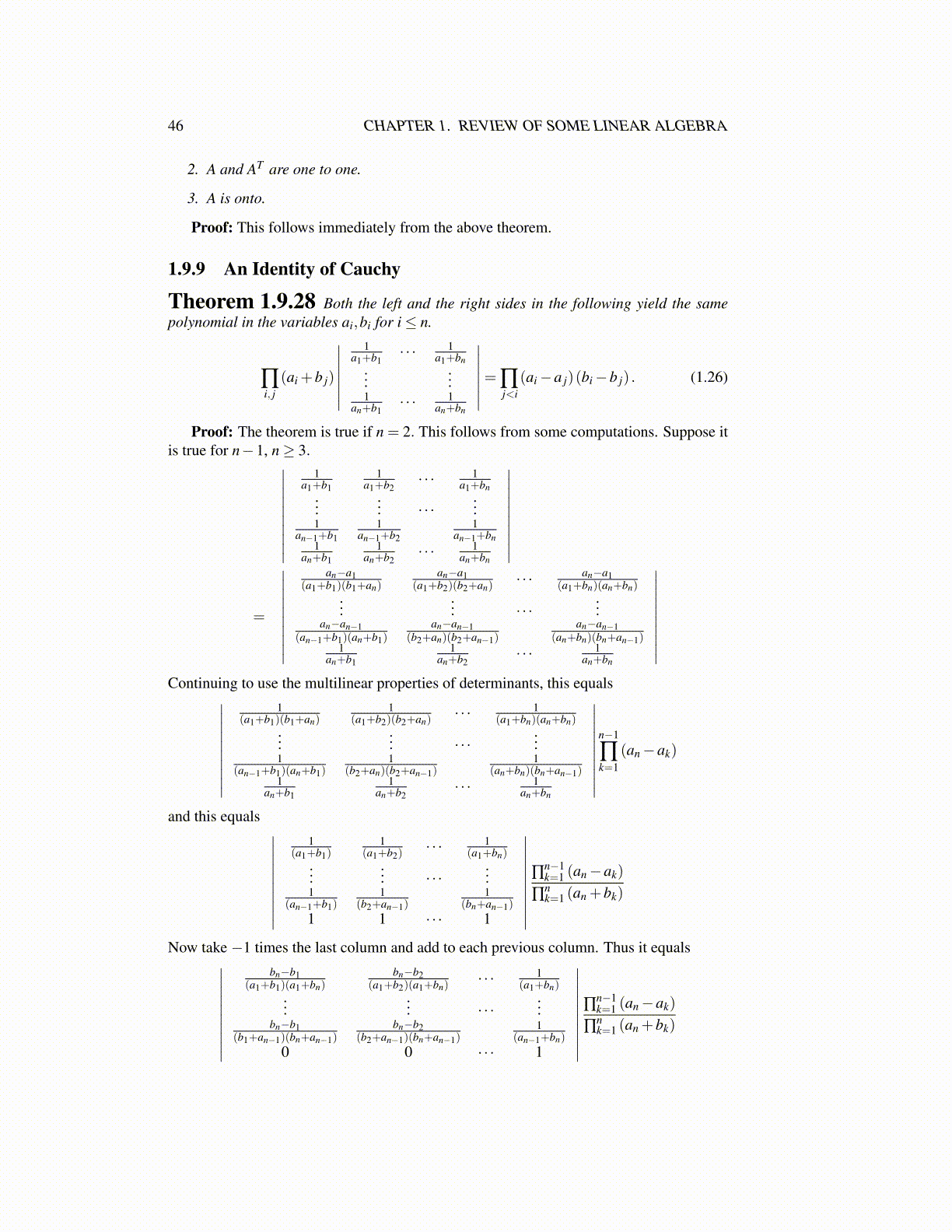
46 CHAPTER 1. REVIEW OF SOME LINEAR ALGEBRA
2. A and AT are one to one.
3. A is onto.
Proof: This follows immediately from the above theorem.
1.9.9 An Identity of Cauchy
Theorem 1.9.28 Both the left and the right sides in the following yield the samepolynomial in the variables ai,bi for i≤ n.
∏i, j
(ai +b j)
∣∣∣∣∣∣∣1
a1+b1· · · 1
a1+bn...
...1
an+b1· · · 1
an+bn
∣∣∣∣∣∣∣= ∏j<i
(ai−a j)(bi−b j) . (1.26)
Proof: The theorem is true if n = 2. This follows from some computations. Suppose itis true for n−1, n≥ 3.∣∣∣∣∣∣∣∣∣∣
1a1+b1
1a1+b2
· · · 1a1+bn
...... · · ·
...1
an−1+b11
an−1+b21
an−1+bn1
an+b11
an+b2· · · 1
an+bn
∣∣∣∣∣∣∣∣∣∣=
∣∣∣∣∣∣∣∣∣∣
an−a1(a1+b1)(b1+an)
an−a1(a1+b2)(b2+an)
· · · an−a1(a1+bn)(an+bn)
...... · · ·
...an−an−1
(an−1+b1)(an+b1)an−an−1
(b2+an)(b2+an−1)an−an−1
(an+bn)(bn+an−1)1
an+b11
an+b2· · · 1
an+bn
∣∣∣∣∣∣∣∣∣∣Continuing to use the multilinear properties of determinants, this equals∣∣∣∣∣∣∣∣∣∣
1(a1+b1)(b1+an)
1(a1+b2)(b2+an)
· · · 1(a1+bn)(an+bn)
...... · · ·
...1
(an−1+b1)(an+b1)1
(b2+an)(b2+an−1)1
(an+bn)(bn+an−1)1
an+b11
an+b2· · · 1
an+bn
∣∣∣∣∣∣∣∣∣∣n−1
∏k=1
(an−ak)
and this equals ∣∣∣∣∣∣∣∣∣∣
1(a1+b1)
1(a1+b2)
· · · 1(a1+bn)
...... · · ·
...1
(an−1+b1)1
(b2+an−1)1
(bn+an−1)
1 1 · · · 1
∣∣∣∣∣∣∣∣∣∣∏
n−1k=1 (an−ak)
∏nk=1 (an +bk)
Now take −1 times the last column and add to each previous column. Thus it equals∣∣∣∣∣∣∣∣∣∣
bn−b1(a1+b1)(a1+bn)
bn−b2(a1+b2)(a1+bn)
· · · 1(a1+bn)
...... · · ·
...bn−b1
(b1+an−1)(bn+an−1)bn−b2
(b2+an−1)(bn+an−1)1
(an−1+bn)
0 0 · · · 1
∣∣∣∣∣∣∣∣∣∣∏
n−1k=1 (an−ak)
∏nk=1 (an +bk)